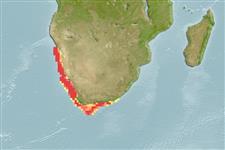>
Ophidiiformes (Cusk eels) >
Ophidiidae (Cusk-eels) > Ophidiinae
Etymology: Genypterus: Greek, geny, -yos = face, jaw + Greek, pteron, = wing, fin (Ref. 45335).
Environment: milieu / climate zone / depth range / distribution range
Ökologie
seewasser bathydemersal; tiefenbereich 50 - 500 m (Ref. 4103), usually 250 - 350 m (Ref. 27121). Deep-water; 21°S - 37°S, 12°E - 28°E (Ref. 34024)
Eastern Atlantic: Walvis Bay, Namibia to Algoa Bay, South Africa. Distinctiveness of this species and Genypterus blacodes is unclear (Ref. 34024).
Length at first maturity / Size / Gewicht / Alter
Maturity: Lm 67.5, range 60 - 75 cm
Max length : 180 cm TL Männchen/unbestimmt; (Ref. 3686); max. veröff. Gewicht: 15.0 kg (Ref. 9988)
Kurzbeschreibung
Morphologie | Morphometrie
Rückenflossenweichstrahlen (insgesamt): 150; Afterflossenweichstrahlen: 110. Head and body usually pinkish to orangish with dark spots and blotches especially dorsally (Ref. 34024).
Occur in rocky areas of the shelf and upper continental slope. Juveniles found in shallow waters than adults (Ref. 36731). Benthic and common species (Ref. 34024). Feed on dragonets, mantis shrimps, hake, squid, and various fishes (Ref. 27121). Spawning occurs from August to October. Oviparous, with oval pelagic eggs floating in a gelatinous mass (Ref. 205). Utilized fresh and frozen; can be fried and baked (Ref. 9988).
Nielsen, J.G., D.M. Cohen, D.F. Markle and C.R. Robins, 1999. Ophidiiform fishes of the world (Order Ophidiiformes). An annotated and illustrated catalogue of pearlfishes, cusk-eels, brotulas and other ophidiiform fishes known to date. FAO Fish. Synop. 125(18):178p. Rome: FAO. (Ref. 34024)
IUCN Rote Liste Status (Ref. 130435)
Bedrohung für Menschen
Harmless
Nutzung durch Menschen
Fischereien: kommerziell
Mehr Information
ReferenzenAquakulturAquakultur ProfilZuchtlinienGenetikElectrophoresesVererbbarkeitKrankheitenVerarbeitungNutrientsMass conversion
Tools
Zusatzinformationen
Download XML
Internet Quellen
Estimates based on models
Preferred temperature (Ref.
123201): 9 - 15.5, mean 9.5 °C (based on 14 cells).
Phylogenetic diversity index (Ref.
82804): PD
50 = 0.5156 [Uniqueness, from 0.5 = low to 2.0 = high].
Bayesian length-weight: a=0.00224 (0.00115 - 0.00437), b=3.16 (2.99 - 3.33), in cm total length, based on LWR estimates for this species & (Sub)family-body (Ref.
93245).
Trophic level (Ref.
69278): 4.4 ±0.61 se; based on food items.
Widerstandsfähigkeit (Ref.
120179): niedrig, Verdopplung der Population dauert 4,5 - 14 Jahre. (K=0.06-0.14; tm=4-5).
Prior r = 0.17, 95% CL = 0.11 - 0.26, Based on 1 stock assessment.
Fishing Vulnerability (Ref.
59153): High to very high vulnerability (73 of 100).
Climate Vulnerability (Ref.
125649): High vulnerability (64 of 100).
Nutrients (Ref.
124155): Calcium = 12.1 [7.6, 26.2] mg/100g; Iron = 0.354 [0.185, 0.683] mg/100g; Protein = 15.6 [13.7, 17.7] %; Omega3 = 0.242 [0.131, 0.475] g/100g; Selenium = 26.1 [11.8, 57.4] μg/100g; VitaminA = 8.8 [1.9, 40.5] μg/100g; Zinc = 0.247 [0.165, 0.370] mg/100g (wet weight);
